Transforming America's Industrial Landscape: Visualizing the Steam-Powered Revolution
The Dawn of Industrial Transformation Through Visual Expression
The steam-powered revolution transformed America from a primarily agrarian society into an industrial powerhouse. Through innovative visualizations, we can better understand how this monumental shift reshaped the nation's economic, social, and physical landscape, creating the foundation for modern America.
The Dawn of Industrial Transformation
Before the industrial revolution, America was predominantly agricultural, with small-scale manufacturing and craftsmanship as the foundation of its economy. To truly understand the magnitude of the industrial transformation, we must first visualize the pre-industrial landscape.
Pre-Industrial American Landscape

Interactive map visualizing America's pre-industrial landscape circa 1790, highlighting agricultural regions and early manufacturing centers.
In pre-industrial America, economic activity clustered around waterways which provided both transportation and power for early mills. Towns were relatively small, and the vast majority of Americans lived in rural settings where they engaged in subsistence farming or produced goods for local markets. Map data visualization basics are essential for understanding how geography shaped early American industrial development.
Socioeconomic Conditions: Setting the Stage
The socioeconomic landscape of early America created conditions ripe for industrial transformation. Rising population, expanding markets, and increasing demand for manufactured goods set the stage for innovation.
As this visualization illustrates, nearly 80% of Americans worked in agriculture before the industrial revolution. This data-driven approach to understanding history allows us to see the dramatic shift that was about to unfold, transforming America from an agrarian society to an industrial powerhouse.
Key Innovations: Visual Timeline
A series of pivotal inventions and innovations sparked the steam revolution in America. This timeline visualizes the progression of key technological breakthroughs that laid the groundwork for industrial transformation.
timeline
title Key Innovations of the Steam Revolution in America
1712 : Newcomen Atmospheric Engine (England)
1769 : Watt's Steam Engine Patent (England)
1787 : First American Steamboat Tested by John Fitch
1793 : Cotton Gin Invented by Eli Whitney
1807 : Commercial Steamboat Service (Fulton's Clermont)
1825 : First American Steam Locomotive
1830 : First Commercial Railroad (Baltimore & Ohio)
1840s : High-Pressure Steam Engines Widely Adopted
1850s : Compound Steam Engines Improve Efficiency
1869 : Transcontinental Railroad Completed
These innovations didn't occur in isolation but built upon each other, creating a cascade of technological advancement. The line graphs to visualize trends in patent registrations during this period show a dramatic increase in steam-related inventions between 1820-1860.
Before-and-After Visual Comparisons
Using PageOn.ai's AI Blocks feature, we can construct clear visual comparisons that demonstrate how American towns and cities were transformed by industrialization. These visuals highlight not just the physical changes but the functional reorganization of space around new centers of production.

Lowell, Massachusetts circa 1820: Small-scale water-powered manufacturing

Lowell, Massachusetts circa 1850: Large-scale steam-powered textile manufacturing center
These visual transformations illustrate how steam power facilitated the concentration of manufacturing in cities, fundamentally changing the relationship between population centers and transportation networks. The application of data visualization techniques to historical information allows us to better understand these dramatic changes.
Steam Power: The Heartbeat of Industrial America
Steam power was the technological breakthrough that made the industrial revolution possible. By converting heat energy from burning fuel into mechanical work, steam engines provided unprecedented power that could be deployed anywhere - not just along waterways.
How Steam Engines Work
flowchart TD
A[Boiler/Water Heating] -->|Steam Production| B[Steam Chest]
B -->|Steam Distribution| C[Cylinder]
C -->|Pressure on Piston| D[Connecting Rod & Crank]
D -->|Rotary Motion| E[Flywheel]
E -->|Power Transmission| F[Machinery]
C -->|Used Steam| G[Condenser]
G -->|Condensed Water| A
style A fill:#FF8000,stroke:#333,stroke-width:1px
style B fill:#FFB266,stroke:#333,stroke-width:1px
style C fill:#FFB266,stroke:#333,stroke-width:1px
style D fill:#FFD699,stroke:#333,stroke-width:1px
style E fill:#FFD699,stroke:#333,stroke-width:1px
style F fill:#FFE6CC,stroke:#333,stroke-width:1px
style G fill:#FFE6CC,stroke:#333,stroke-width:1px
Basic operation of a steam engine: Heat converts water to steam, creating pressure that moves a piston, which is converted to rotational motion.
This simplified diagram illustrates the fundamental principles behind steam engine operation. Water is heated in a boiler, producing high-pressure steam that is directed to push a piston within a cylinder. The linear motion of the piston is converted to rotary motion through a connecting rod and crank mechanism, which can then power various types of machinery. The spent steam is then cooled in a condenser, returning to water form to begin the cycle again.
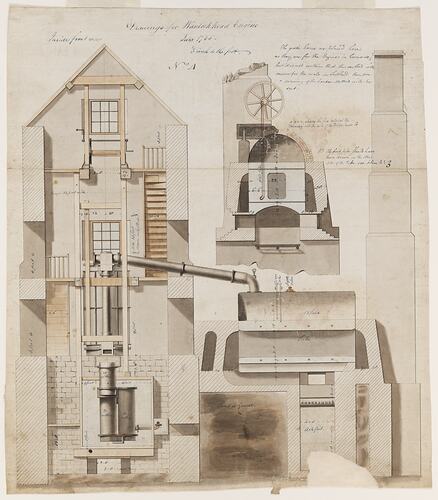
Detailed cutaway view of a Watt-style steam engine showing key components
Manufacturing Output Growth
The implementation of steam power led to an exponential increase in manufacturing output across America. This visualization demonstrates the dramatic growth in key industries from 1820 to 1880.
As this chart illustrates, the implementation of steam-powered manufacturing led to unprecedented growth in industrial output. Textiles, iron production, and machinery manufacturing all saw exponential increases once steam power became widely adopted. The development of data visualization charts like these helps us better understand the magnitude and pace of industrial transformation.
Water vs. Steam Power Comparison
| Characteristic | Water Power | Steam Power | Advantage |
|---|---|---|---|
| Location | Limited to waterways | Can be placed anywhere | Steam |
| Power Output | Variable (seasonal) | Consistent | Steam |
| Scalability | Limited by water flow | Highly scalable | Steam |
| Fuel Cost | Free (once mill built) | Ongoing coal expense | Water |
| Initial Investment | High (dam construction) | Moderate (engine only) | Steam |
| Operational Hours | Limited by daylight | 24 hours possible | Steam |
This comparison demonstrates why steam power ultimately superseded water power as America's primary industrial energy source. While water power had some economic advantages, the flexibility, consistency, and scalability of steam power made it the driving force behind America's industrial revolution.
Regional Adoption of Steam Technology
Steam technology did not spread uniformly across America. Its adoption was influenced by factors including access to coal, existing industrial infrastructure, and economic specialization.

Regional adoption of steam technology 1850-1860, with darker shades indicating higher concentration of steam engines
PageOn.ai's Deep Search functionality allows us to integrate historical diagrams and patents with modern explanatory graphics, creating a richer understanding of how steam technology evolved and spread throughout America. This approach to interactive visualizations for data exploration makes complex historical patterns more accessible and engaging.
Railroads: Stitching a Nation Together
If steam engines were the heart of the industrial revolution, railroads were its circulatory system. The expansion of rail networks transformed America's economic geography, collapsed travel times, and created a truly national market for the first time.
Expansion of Railroad Networks (1830-1890)
The growth of American railroads represents one of the most dramatic infrastructure expansions in human history. Through dynamic timeline maps, we can visualize how this network evolved over time.

American Railroad Network in 1840

American Railroad Network in 1890
This exponential growth transformed America. In just 60 years, the United States went from having just 23 miles of railroad to over 166,000 miles – the largest rail network in the world. This represented not just a technological achievement but a reshaping of America's economic landscape.
The Collapse of Travel Times
One of the most profound impacts of railroads was the dramatic reduction in travel times across America. This transformation can be visualized through isochrone maps, which show the travel times from a central point to surrounding areas.

Isochrone map comparing travel times from New York City in 1830 (pre-railroad dominance) vs. 1870 (post-railroad)
This dramatic reduction in travel times had profound implications for business, communication, and culture. Markets became more integrated, goods could be shipped faster and more reliably, and Americans gained unprecedented mobility.
Technical Evolution of Steam Locomotives
The steam locomotive itself underwent remarkable evolution during this period. Using PageOn.ai's visual progression tools, we can illustrate how locomotives became more powerful, efficient, and specialized over time.
timeline
title Evolution of American Steam Locomotives
section Early Period
1830 : Tom Thumb (B&O Railroad)
: First American-built locomotive
: 4 mph top speed
1831 : DeWitt Clinton (Mohawk & Hudson)
: 3-2-0 wheel arrangement
section Standardization
1837 : 4-4-0 "American" Type Appears
: Becomes dominant design for decades
1850s : Higher boiler pressures (100+ psi)
: Cast iron replaced with steel components
section Growth & Specialization
1860s : Specialized freight locomotives
: 2-8-0 "Consolidation" type
1870s : Compound cylinders introduced
: Improved fuel efficiency
1876 : Westinghouse air brakes
section Maturity
1880s : 4-6-0 "Ten-Wheeler" becomes popular
: Multiple drive wheels for more power
1890s : 2-8-2 "Mikado" heavy freight engines
: Superheaters improve efficiency
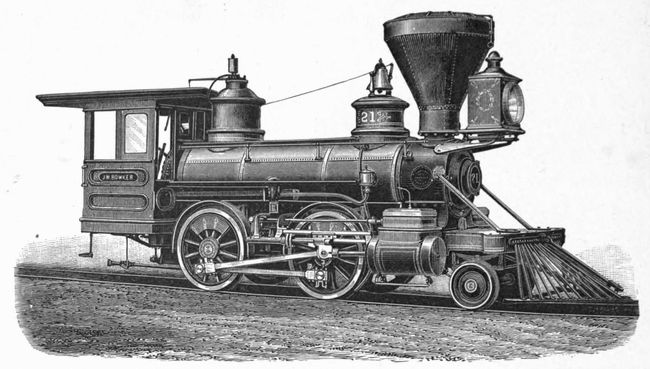
Visual comparison showing the evolution of American steam locomotives from 1830-1890
This technical evolution dramatically increased the power, efficiency, and reliability of steam locomotives. Early engines could pull only a few cars at slow speeds, while later locomotives could haul dozens of cars at 60 mph or more.
Transformation of Goods Transport
The impact of railroads on goods transport was revolutionary. The following data visualization compares the cost, speed, and capacity of different transportation methods.
As this radar chart visualization clearly demonstrates, railroads outperformed all other transportation methods of the era across nearly every dimension. They were faster, more reliable, had greater capacity, and could operate in most weather conditions. This superiority fundamentally transformed American commerce and industry by dramatically reducing transportation costs and expanding market reach.
Economic Ripple Effects
The industrial revolution, powered by steam, created profound economic transformations that reshaped every aspect of American life. These changes were felt far beyond the factories and railroad lines, rippling through the entire economy.
Industrial Output Growth Across Sectors
This comparative visualization demonstrates how growth was unevenly distributed across different sectors of the economy. Manufacturing and transportation—both heavily influenced by steam power—grew most dramatically, while agriculture, though still expanding, grew at a much slower rate.
Rural to Urban Population Shift
As factories concentrated in cities, America's population distribution dramatically shifted from predominantly rural to increasingly urban. These animated demographic visualizations capture this transformation.

Animated visualization of population movement patterns from rural to urban areas, 1840-1880
This demographic shift had profound implications for American society, politics, and culture. Cities expanded rapidly, often without adequate infrastructure to support their growing populations. New forms of urban poverty emerged alongside unprecedented industrial wealth.
Wage and Productivity Changes
This visualization reveals a critical economic reality of the industrial revolution: while both productivity and wages increased, productivity grew much more rapidly than worker compensation. This divergence created new tensions between labor and capital that would shape American politics and society for generations.
Railroad Expansion and Agricultural Market Access
The expansion of railroads dramatically transformed American agriculture by connecting even remote farms to national and international markets. This connectivity allowed for regional specialization and dramatically expanded the market reach of agricultural products.

Visualization showing how railroads connected agricultural production regions to distant markets, enabling regional specialization
Using PageOn.ai's AI Blocks, we can build layered visualizations that illustrate the complex cause-and-effect relationships between railroad expansion, agricultural specialization, and market integration. These connections fundamentally reshaped the American economy, creating the foundations for modern agribusiness and national consumer markets.
Environmental Impact and Landscape Changes
The industrial revolution fundamentally altered America's physical landscape. Steam power required vast amounts of fuel, primarily coal, while railroads consumed enormous quantities of timber and iron. These resource demands transformed forests, created mining landscapes, and generated unprecedented forms of pollution.
Before and After Landscape Visualizations
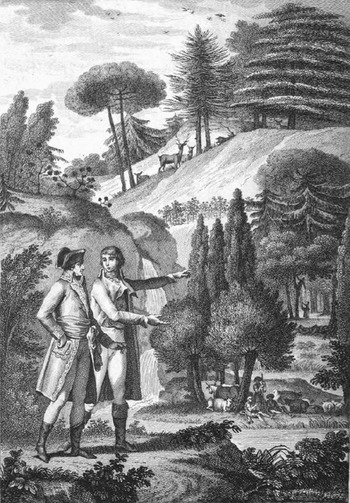
Pennsylvania Appalachian region circa 1820, before intensive coal mining

The same region circa 1880, showing the impact of coal mining operations
These comparative visualizations illustrate the dramatic transformation of America's natural landscapes during the industrial revolution. Mining regions were particularly impacted, with entire mountains reshaped, forests cleared, and waterways altered for resource extraction.
Resource Extraction Rates
This data visualization illustrates the exponential growth in resource extraction that fueled America's industrial revolution. Coal production, in particular, increased more than 100-fold during this period, from approximately 1.3 million tons in 1840 to over 157 million tons by 1890, with profoundly transformative effects on mining regions and the broader American landscape.
Industrial Centers and Resource Geography
flowchart LR
subgraph "Raw Materials"
A1[Coal Mining Districts]
A2[Iron Ore Regions]
A3[Forest Reserves]
end
subgraph "Transport Networks"
B1[Railroad Networks]
B2[Canal Systems]
B3[River Transport]
end
subgraph "Industrial Centers"
C1[Pittsburgh]
C2[Chicago]
C3[Detroit]
C4[Cleveland]
C5[Buffalo]
end
subgraph "Markets"
D1[Eastern Seaboard]
D2[Midwest]
D3[Export Markets]
end
A1 --> B1 & B2 & B3
A2 --> B1 & B3
A3 --> B1 & B3
B1 & B2 & B3 --> C1 & C2 & C3 & C4 & C5
C1 & C2 & C3 & C4 & C5 --> D1 & D2
D1 & D2 --> D3
style A1 fill:#78909C,stroke:#333,stroke-width:1px
style A2 fill:#FF8000,stroke:#333,stroke-width:1px
style A3 fill:#8BC34A,stroke:#333,stroke-width:1px
style B1 fill:#FFB266,stroke:#333,stroke-width:1px
style B2 fill:#66BBFF,stroke:#333,stroke-width:1px
style B3 fill:#66BBFF,stroke:#333,stroke-width:1px
style C1 fill:#FFD699,stroke:#333,stroke-width:1px
style C2 fill:#FFD699,stroke:#333,stroke-width:1px
style C3 fill:#FFD699,stroke:#333,stroke-width:1px
style C4 fill:#FFD699,stroke:#333,stroke-width:1px
style C5 fill:#FFD699,stroke:#333,stroke-width:1px
style D1 fill:#FFE6CC,stroke:#333,stroke-width:1px
style D2 fill:#FFE6CC,stroke:#333,stroke-width:1px
style D3 fill:#FFE6CC,stroke:#333,stroke-width:1px
This flow diagram illustrates how America's industrial geography was shaped by resource availability and transportation networks. Cities like Pittsburgh developed at the intersection of coal resources, iron ore deposits, and water transportation routes. As railroads expanded, industrial centers could develop in more locations, but they remained strongly tied to resource geography.

Map visualization of the relationship between industrial centers and resource extraction regions in 1880
Environmental Challenges and Pollution Patterns
The industrial revolution created unprecedented environmental challenges as factories, locomotives, and steamships released enormous quantities of smoke, ash, and chemical waste.
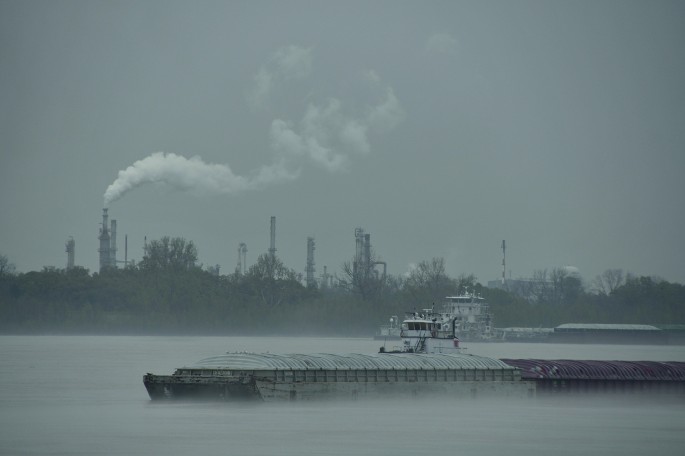
Environmental storytelling visualization: Pittsburgh's air quality crisis of the 1880s, combining historical photography with data visualization
Using PageOn.ai's Deep Search, we can integrate historical photographs with data visualization to tell compelling stories about the environmental consequences of industrialization. These early pollution challenges eventually led to some of America's first environmental regulations and movements for industrial reform. Understanding this history provides valuable context for modern environmental challenges and solutions.
Legacy and Modern Connections
The steam-powered industrial revolution laid the foundations for modern America in countless ways. Its legacy persists in our infrastructure, economy, social structures, and technological development.
Technological Evolution Threads
timeline
title From Steam Power to Modern Energy Systems
section Steam Era
1830s : Steam Locomotives
: Stationary Steam Engines
1860s : Compound Steam Engines
: High-pressure Boilers
1880s : Steam Turbines
section Transition Era
1890s : Internal Combustion Engines
: Early Electric Power Generation
1910s : Electric Motors Replace Steam in Factories
: Diesel-Electric Locomotives
1930s : Steam Power Plants for Electricity
section Modern Era
1950s : Nuclear Power Plants (Steam Turbines)
1970s : Combined Cycle Gas Turbines
1990s : High-efficiency Steam for Power Generation
2010s : Renewable Energy with Energy Storage
: Distributed Energy Generation
This visualization traces the evolutionary path from early steam technology to modern energy systems. Many of our current power generation methods—including nuclear, coal, and natural gas—still rely on steam turbines, a direct descendant of industrial-era steam engines. The principles of thermal energy conversion pioneered during the industrial revolution remain fundamental to modern power generation.
Enduring Infrastructure Legacy
The physical infrastructure developed during the industrial revolution continues to shape American geography and transportation networks today.
Mapping the enduring infrastructure legacy: Overlay of 1890 railroad networks with modern transportation corridors
This comparative visualization demonstrates how modern transportation corridors—including highways, modern railroads, and even fiber optic lines—often follow routes established during the industrial revolution. Many major American cities owe their prominence and location to their role as industrial centers or transportation hubs during this period.
Industrial vs. Modern Economic Patterns
This radar chart visualization compares the economic focus of industrial America with that of modern America. While manufacturing and resource extraction dominated the industrial economy, today's economy places greater emphasis on services, information processing, and finance. Yet despite these differences, both periods represent times of rapid innovation and economic transformation.
What If Scenarios: America Without Steam
Using PageOn.ai's AI Blocks, we can construct visual "what if" scenarios that explore how America might have developed without the steam revolution.
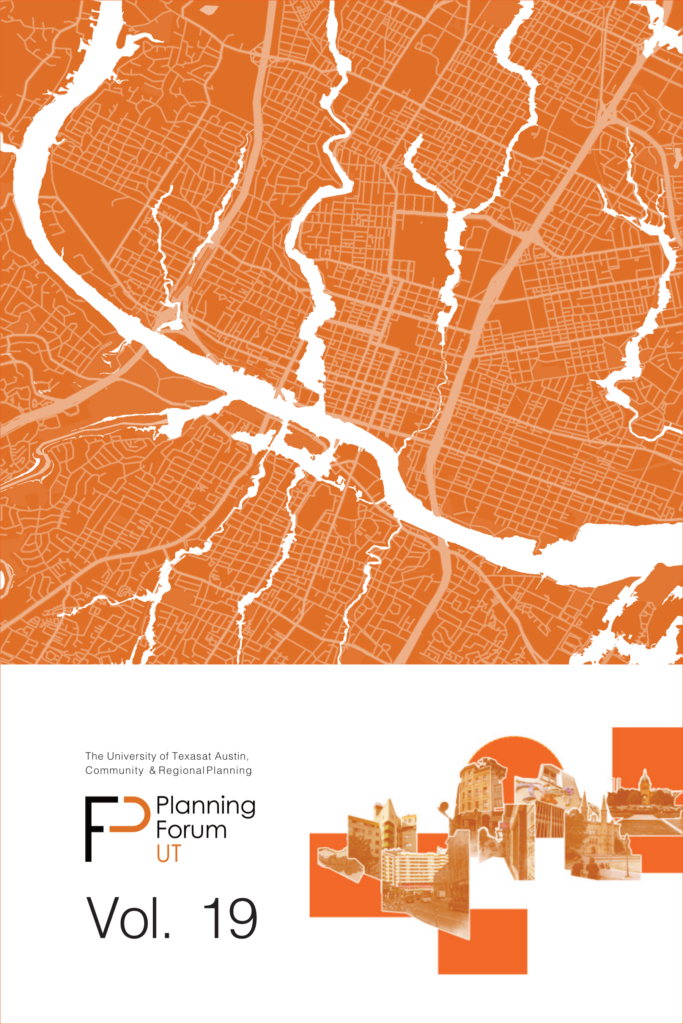
Visual scenario: Alternative America without the steam revolution, showing decentralized development patterns
This counterfactual visualization helps us understand the profound impact that steam power had on American development. Without steam, industrial development would likely have remained tied to waterways, limiting the scale and geographic distribution of manufacturing. Transportation would have evolved much more slowly, making national market integration more difficult. These alternative scenarios highlight just how transformative the steam-powered industrial revolution truly was in shaping modern America.
Transform Your Historical Data into Compelling Visualizations with PageOn.ai
Turn complex historical information into clear, engaging visual stories that illuminate the past and connect it to the present. Whether you're teaching, researching, or presenting, PageOn.ai's powerful visualization tools bring history to life.
Start Creating with PageOn.ai TodayFrom Past to Present: Visualizing Our Industrial Heritage
The steam-powered industrial revolution that transformed America in the 19th century continues to shape our world today. Through thoughtful visualization of historical data and trends, we can better understand both this pivotal period and its ongoing legacy.
As we've seen, the impact of steam power and railroads went far beyond technological change. They reshaped America's economic geography, social structures, physical landscapes, and cultural patterns. Modern America—with its urban centers, integrated markets, industrial capacity, and transportation networks—was built on foundations laid during this transformative era.
By using tools like PageOn.ai to create compelling data visualizations and visual narratives, we can make these complex historical processes more accessible and engaging. This approach not only enriches our understanding of history but also helps us see the connections between past innovations and present challenges, providing valuable context for understanding our current technological transformations.
You Might Also Like
How to Design Science Lesson Plans That Captivate Students
Create science lesson plans that captivate students with hands-on activities, clear objectives, and real-world applications to foster curiosity and critical thinking.
How to Write a Scientific Review Article Step by Step
Learn how to write a review article in science step by step. Define research questions, synthesize findings, and structure your article for clarity and impact.
How to Write a Self-Performance Review with Practical Examples
Learn how to write a self-performance review with examples and tips. Use an employee performance review work self evaluation sample essay to guide your process.
How to Write a Spec Sheet Like a Pro? [+Templates]
Learn how to create a professional spec sheet with key components, step-by-step guidance, and free templates to ensure clarity and accuracy.

Social and Cultural Transformation
The industrial revolution was not merely an economic transformation but a profound social and cultural one as well. Steam power and railroads altered the fabric of American society, creating new social classes, reshaping communities, and transforming daily life.
Changing Class Structures
The industrial revolution created new social hierarchies and occupational categories, transforming America's class structure.
graph TD subgraph "Pre-Industrial America (1820)" A1[Landowners & Merchants] --> B1[Skilled Artisans] B1 --> C1[Small Farmers] C1 --> D1[Unskilled Labor & Servants] D1 --> E1[Slaves & Indentured Servants] end subgraph "Industrial America (1880)" A2[Industrialists & Financiers] --> B2[Professional Class] B2 --> C2[Skilled Industrial Workers] B2 --> C3[White-Collar Workers] C2 --> D2[Factory Workers] C3 --> D3[Service Workers] D2 --> E2[Unskilled Laborers] D3 --> E2 C2 --> F2[Farmers] end style A1 fill:#FFD699,stroke:#333,stroke-width:1px style A2 fill:#FF8000,stroke:#333,stroke-width:1px style B1 fill:#FFD699,stroke:#333,stroke-width:1px style B2 fill:#FF8000,stroke:#333,stroke-width:1px style C1 fill:#FFD699,stroke:#333,stroke-width:1px style C2 fill:#FF8000,stroke:#333,stroke-width:1px style C3 fill:#FF8000,stroke:#333,stroke-width:1px style D1 fill:#FFD699,stroke:#333,stroke-width:1px style D2 fill:#FF8000,stroke:#333,stroke-width:1px style D3 fill:#FF8000,stroke:#333,stroke-width:1px style E1 fill:#FFD699,stroke:#333,stroke-width:1px style E2 fill:#FF8000,stroke:#333,stroke-width:1px style F2 fill:#FF8000,stroke:#333,stroke-width:1pxThis comparative visualization illustrates how industrialization created entirely new social categories and occupations while diminishing the relative importance of others. The traditional artisan class, for example, declined as factory production replaced handicraft methods, while new professional and managerial classes emerged to oversee increasingly complex industrial enterprises.
Immigrant Experiences and Contributions
The industrial revolution coincided with—and partly fueled—a massive wave of immigration to the United States. Immigrants provided essential labor for factories, mines, and railroads while transforming American culture and society.
Immigrant laborers constructing the transcontinental railroad: Chinese workers (Central Pacific) and Irish workers (Union Pacific)
These visualizations highlight the essential contributions of immigrants to America's industrial development. The transcontinental railroad, for example, was built largely by Chinese laborers in the West and Irish laborers in the East. In factories across the country, immigrants provided the labor that powered America's industrial revolution.
Urban Growth Patterns
The industrial revolution fueled explosive urban growth as factories concentrated in cities and workers flocked to industrial centers seeking employment.
Visual comparison of Pittsburgh's skyline: 1840 vs. 1890, illustrating the physical transformation of industrial cities
As these visualizations demonstrate, industrial cities grew at unprecedented rates during this period. Chicago's growth was particularly dramatic, expanding from a small town of 4,000 in 1840 to a major metropolis of over 1 million by 1890. This explosive growth created significant challenges related to housing, sanitation, transportation, and governance.
Evolution of Daily Life
The industrial revolution transformed everyday life for Americans across all social classes. Using PageOn.ai's Vibe Creation feature, we can develop immersive visual scenarios that depict these changes.
Pre-Industrial Craft Production: Individual artisans creating products by hand
Industrial Factory: Mass production with specialized tasks and steam-powered machinery
These visual comparisons highlight how industrialization fundamentally changed the nature of work, shifting from skilled craftwork to more specialized, machine-oriented labor. Similar transformations occurred in transportation, communication, retail, and domestic life, as steam power and industrial production reshaped every aspect of American society.